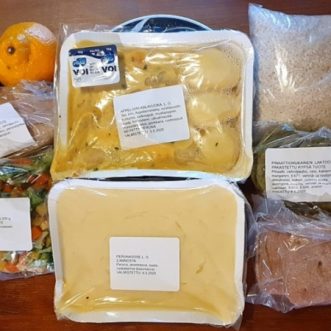
Just in Time
I’ve been a just-in-time practitioner for much of my life. It’s how I used to do all my homework. Sometimes, … Read More “Just in Time”

I’ve been a just-in-time practitioner for much of my life. It’s how I used to do all my homework. Sometimes, … Read More “Just in Time”

I was tidying up my digital desktop today, and came across an old article by Umair Haque, written for HBR magaizine.
6 years after it was published, Haque’s message seems more important than ever.
If you want customers that come back to your business regularly, freely, joyfully, “focus on giving people what matters most to them — but what they feel cheated of, stymied from, and suffocated by at every turn. Improve their lives. Deliver lasting gains in their quality of life. Don’t just carrot-and-stick them into “loyalty.” Be loyal to them. Don’t win their attention — give them your attention. And one tiny interaction at a time, help them live lives richer with meaning, happiness, and purpose.”
And always be asking this question: “How loyal can we be to our customers?”

Sometimes you can’t just do, you have to think about what you’re doing.
Sometimes you can’t just think, you have to think about what you’re thinking.
Sometimes you can’t just think about what you’re doing or thinking, you have to think about how you’re thinking or doing it.
Sometimes you can’t just think about how, you have to think about why.
It would be exhausting to operate like this all the time, but every now and then, it pays to take yourself up a level or two, perhaps with the help of other people, or a book, or a video, or a podcast or a tool.
Because once you are aware of what, how and why, you can repeat your best doing or thinking, on purpose.

Specifications highlight the difference between value creators and value extractors brilliantly.
Value creators treat specifications as minima. They’re always looking to see far they can go above and beyond, within the time and financial constraints they face. For them the spec is a starting point.
Value extractors, on the other hand, view specs as maxima. They’re always looking to see how little they can get away with, how much they can bend the definitions, while still being able to say they’ve met the specification. For them the spec is the bar, and they’re always trying to lower it.
Extractors win in the short term. But the future belongs to the creators. Especially if they collaborate with each other.
The picture is 2 days worth of lunches for a Finnish schoolchild during lockdown last year.

Good Services principle number 9: A good service is consistent.
I like this principle particularly, because consistent doesn’t mean uniform.
Your services are obviously going to be different if they take place over different channels or formats, or if you have different levels of offering. A one-to-one consultancy isn’t going to be the same as a do-it-yourself option, but your service should live up to your Promise of Value across channels, across time, across customer types and across all individual customer journeys. There should be no gaps – something that takes extra care if your organisational structure is non-orthogonal to your processes.
The great thing about consistency is that it allows for the kind of variation that uniformity would stifle. The kind of variation that allows you people to over-deliver on your Promise and delight individual clients – even when things go wrong. As you design the services that enable your business to deliver though others, remember to empower that ability to vary in your team. Not only will it make for more delight and flexibility, it will be the means by which you discover new needs and desires in your client base.
‘Consistency’ is the perfect word here because it describes how your service should feel.
That’s what keeps it human.

As it happens, I didn’t have to wait long for a lovely illustration for yesterday’s principle: “a good service works in a way that’s familiar.”.
Last night, we made the final decision on the flooring for our new extension. A metre of coconut matting in front of the big outside doors, with the bamboo flooring starting after that and flowing through to the library.
I went online to shop around for the matting. It came in 2 widths, lots of colours (black of course!) and could be cut to size. Everywhere I looked it seemed to be around the same reasonable price of £18 – £20, yet every time I entered my desired dimensions, the price jumped to anywhere between £125 to £450. What was going on? I couldn’t work it out. So I asked a chat line.
This morning the answer came “The price is £18 for 0.25 metres – how much do you need?”.
Doh!
I was expecting to buy this flooring the way I buy every other kind of flooring – by the square metre.
I can sort of see where this convention came from (many people only need .25 or .5 of a metre for a doormat), and why with online shopping, every seller adopted it.
But I bet nobody has thought through what effect it has on sales. First, it feels like you are doing something wrong, then it feels a little bit like a rip-off, because the price you see is nowhere near the price you actually pay. I nearly gave up on the idea altogether.
The answer is simple. Make it work like everything else, then let me know how it’s different. In this case, that I can buy less than a metre if I need to.

The trick to building a business that can scale profitably and last longer than you, is to stop managing people and empower them to manage themselves.
You can support the transition from supervision to responsible autonomy with a framework that works like handrails – supportive, available when you need them, but not overly constricting. I call this framework your ‘Customer Experience Score’.
Another way to think of it, that might be useful for you, is as a set of services that your team use to deliver on what the business does. In this mini-series of blogs, I’m working through the principles outlined in this brilliant book by Lou Downe “Good Services” as a way of exploring this idea.
Principle number 5 makes a lot of sense: “a good service works in a way that’s familiar.”
But.
What exactly does ‘familiar’ mean? The way we’ve always done it? The way everyone else does it? The way a 70-year-old expects it to happen? The way an 8-year-old expects it to happen?
I think in the end, the answer is that however you deliver it, (and there may well be more than one way) it should always feel like it is being delivered by your business. even if – especially if- it also reminds them of something else. Buying from a physical shop is a familiar experience, but Apple has it’s own way of delivering that. Buying online is familiar, but as you’d expect Apple very much has it’s own way of doing that too.
Every service your users run for the people you serve should be recognisably similar to the way your business does everything. In other words it should be congruent with your business’s unique Promise of Value. That doesn’t just reinforce the Promise for customers and clients, it reinforces it for your team too. They’ll be able to tell you when something jars before your customers do.
By all means make your services rhyme with what’s already out there. But the real trick is to build familiarity with your unique way of doing things, so your business becomes an old friend people turn to instinctively.
The right kind of familiarity breeds connection.

You’d think that Keeping your Promise is easy to do. That’s true when everything is going to plan, but when times are hard, or the unexpected happens, it may not be so easy. It may even be impossible.
It’s at these times that questions can help you hold yourself to account for what you do and the way you do it:
If you have more than one set of stakeholders (and it seems to me you’ll always have at least 5 – customers, employees, shareholders, suppliers, your community), then you can also ask:
When you know the answers to these questions, you can ask further, practically useful ones:
If everyone in your business is in the habit of asking these questions in the good times, you’ll be well able to do the right things, the right way, when things are bad.

What happens if it works?
Every improvement we make to our business doesn’t just change the business. It changes us too. And that is a truly scary thought. What if we don’t like our future selves? What if other people don’t like them either?
We forget of course, that our self has changed with every improvement we’ve ever made, and yet we are the same person we’ve always been.
Composing your Customer Experience Score won’t make you a different person. It will simply enable more of the real you to come out.
And by bringing your whole self to bear on composing it, you’ll do the same for everyone that plays it, and everyone that experiences it.

How do you start building an archive and library of ordinary peoples’ diaries? By taking in one box of diaries.
How do you start a hot-air balloon festival? By getting two hot-air balloons together.
How do you start a sail-cargo business? With one hold of cargo.
How do you start writing your Customer Experience Score? By writing down one business process.
By starting. Small. By not worrying about what will be needed to make the big thing a success. Most of all, by moving from “Someone really ought to do something about this.” to “I’d better do something about this.”
Once you start, other people will join in.
Hat tip to Irving Finkel for inspiring this one.